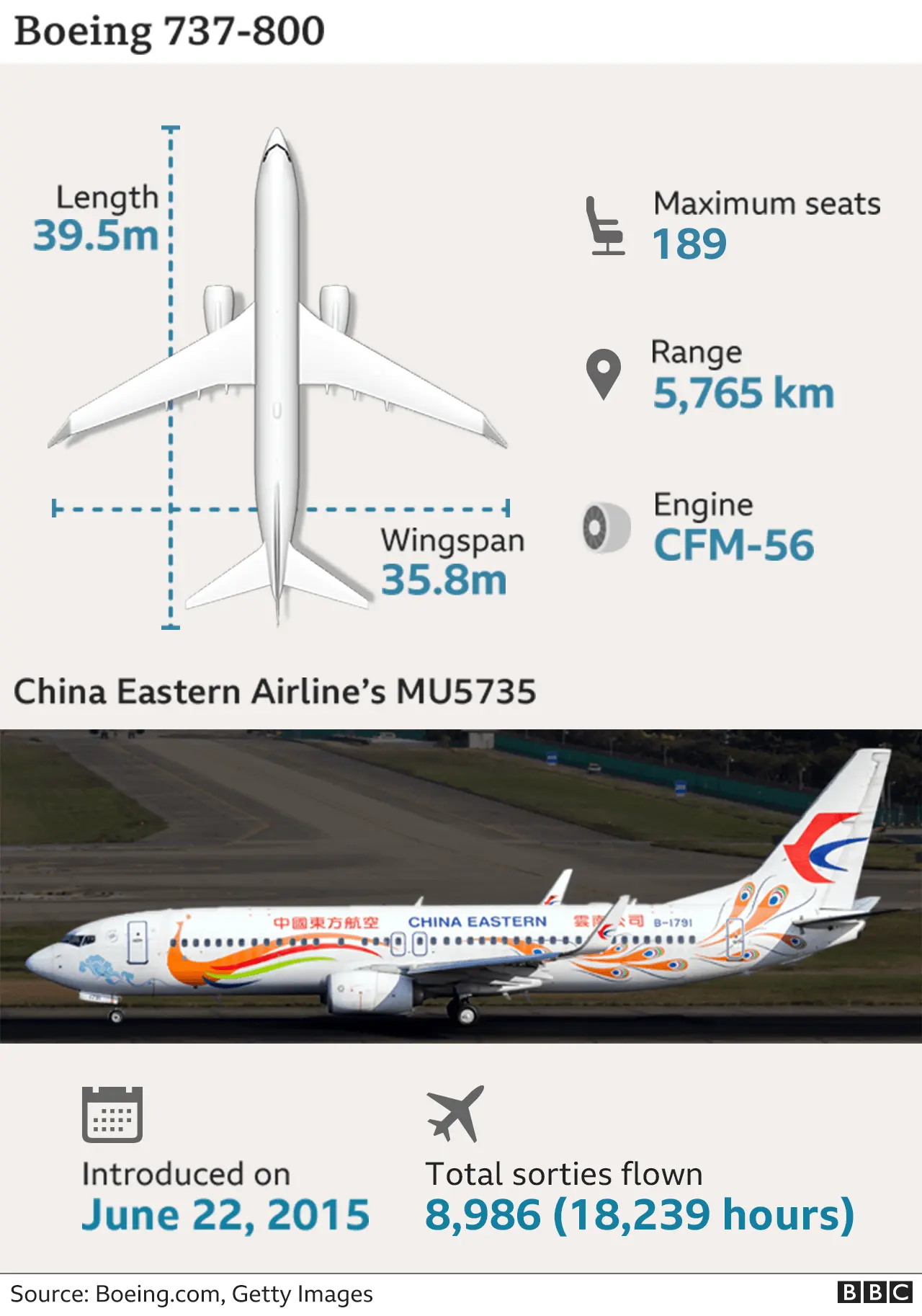China Eastern crash: What do we know so far?
 Reuters
ReutersIt was supposed to be a routine two-hour flight carrying 132 people from one big city to another in southern China.
But just over an hour into its journey, China Eastern Flight MU5735 pitched over into a sudden near-vertical dive.
The Boeing 737-800 jet hurtled to the ground at high speed - thousands of feet a minute - slamming into a hillside in a fiery explosion.
Most of the jet appears to have disintegrated on impact.
But search crews scouring the mountains in Wuzhou, Guangxi province have found charred wreckage, scattered belongings, debris and some human remains.
They've also found a piece critical to the puzzle - one of the two so-called black boxes. The cockpit voice recorder was damaged on the outside but its recordings were still intact.
Investigators are hoping it will explain a disaster confounding aviation experts. What caused the plane to suddenly nosedive and crash?
Here's what we know so far.
Nothing amiss prior to nosedive
Flight MU5735 took off from Kunming at 13:11 local time (05:11 GMT) and was due to arrive, two provinces across, in Guangzhou at 15:05. On board were 123 passengers and nine crew.
The jet was a Boeing 737-800, a model long viewed as a reliable workhorse in the industry.


Airline and aviation officials say they've not found any faults with the plane or concerns about flying conditions.
The Civil Aviation Administration of China (CAAC) said the plane, which was less than seven years old, had passed all checks prior to take-off.
Once in the air, it had also flown the normal flight path, through "not dangerous" weather, said Mao Yanfeng, head of aircraft investigation at CAAC.
Air controllers had been in contact with the plane right until it nosedived, after which they received no response to multiple urgent calls.
Tracking site FlightRadar24 showed the plane cruising along at a typical 29,100ft (about 9,000m). Two minutes and 15 seconds later it had plunged to 9,075ft (2,700m).
The radar data shows the plane reaching maximum descent speeds of 31,000 ft per minute - or 157m per second.

"This is extremely excessive and not something we would normally see in any sort of flight. The aircraft would have been almost vertical," says Dr Sonya Brown, an aviation expert from the University of New South Wales.
At about 7,000-8,000 ft from the ground, there was a slight upturn, the data shows.
But then it continued its high speed plummet to the ground.
Two main theories
"It's very unconventional for a plane to be cruising and then suddenly dive like this," said Dr Brown.
She said it was difficult to determine the cause but "there's really two schools of thought - and I'm not sure I can say which it is at this point".
One is "a catastrophic failure" of the plane's horizontal tail - the part at the back which stabilises the plane and keeps it in line with the direction it's moving.
That could lead to the plane tipping over as it did. "That could be something mechanically caused - for example a runaway stabiliser," she said.
The other option that's increasingly being suggested among experts is sabotage.
"Unfortunately we have seen this in the airline industry before," Dr Brown said.
She mentioned the Germanwings Flight 9525 crash in 2015, where a co-pilot crashed an Airbus carrying 150 people into the French Alps. All on board died on impact.
But she notes that even then, that aircraft only reached descent rates of 3,000-4,000ft per minute, compared to the rate at which Flight MU5735 plummeted.
"So this is a significantly, significantly different scenario - really extreme," Dr Brown said.
Aircraft are designed to glide, she said. "They're not designed to tip over and dive. Even if all engines went out - the plane would slow down a little maybe but it will just glide.
"So in terms of mechanical failure, it's really got to be around pitch control which is around the horizontal tail... so something has to have forced the aircraft down."
What do we know about the pilots?
There were three pilots on the plane, China Eastern officials disclosed on Wednesday. One of them was there as an observer to build up experience.
The captain had 6,709 hours flying experience, while the first and second officers had 31,769 hours and 556 hours respectively.
"From what we know, the performance of the three pilots had been good and their family life relatively harmonious," said airline spokesman Shangguan Xuemin.
He confirmed that typically, the airline deployed only two pilots on short-haul flights as per industry practice.
On Thursday, some Chinese media outlets had begun to name the pilots and their families. These details have yet to be confirmed by authorities.
What can the black boxes tell us?
Authorities have sent the cockpit recorder found on Wednesday to a lab in Beijing where it is hoped the data can be decoded quickly.
The black box, the first one found, was dented by the crash impact, but the data inside appeared stable, officials said.
"If this aircraft was brought down deliberately, that will actually be really helpful because it's going to record every sound in the cockpit - what they were saying, if anyone broke into the cockpit, if any alarms were going off," Dr Brown said.
The other black box - the flight data recorder - is still to be recovered. It would have more information on control settings, air data and other factors which may help illuminate any mechanical issues.
What's happening now?
Chinese investigators have invited US aviation experts to join the investigation, as the Boeing plane was manufactured in the US.
Meanwhile, more than 600 workers and volunteers continue to scour the hillside near Wuzhou, battling wet weather and flooded terrain in a difficult recovery mission.
 Reuters
ReutersThere has been no sign of survivors, though human remains have been found. But Chinese officials have still not officially declared the number of dead.
China Eastern has said it is offering help to 110 families who have "suffered a loss".
Devastated relatives arrived at the site just a day after the crash. Some have spoken briefly to local media, others have posted grief-stricken laments online.
In the meantime, China is carrying out a two-week safety audit of all planes.
China Eastern and its two subsidiaries have also grounded its fleet of Boeing 737-800s as an emergency precaution.
